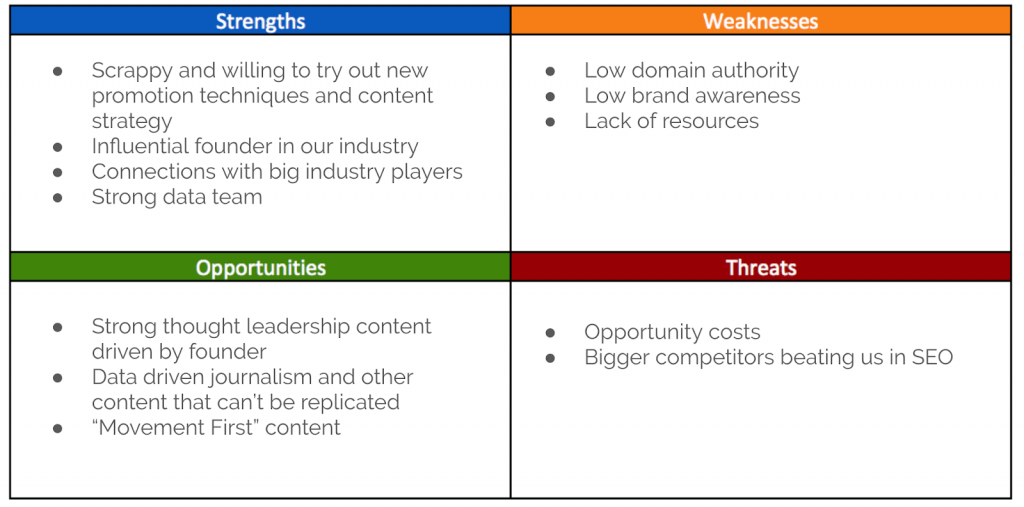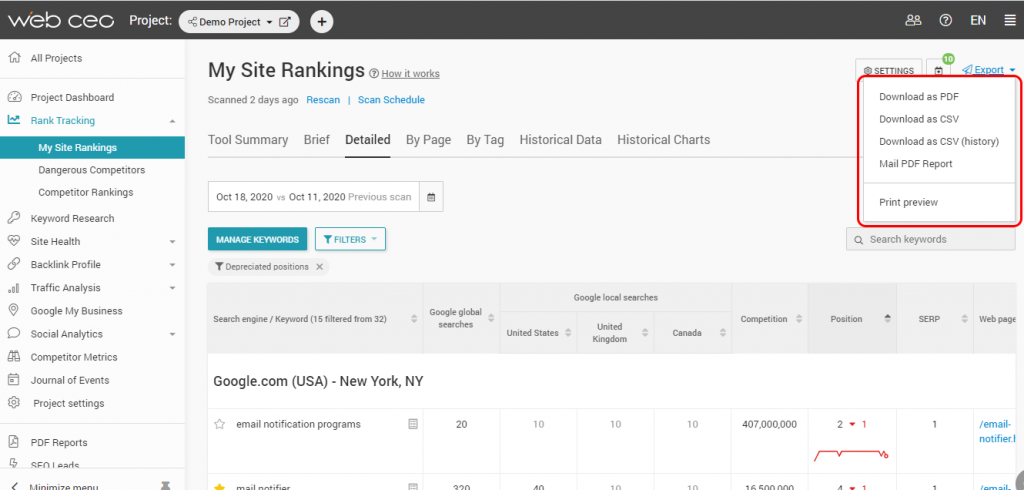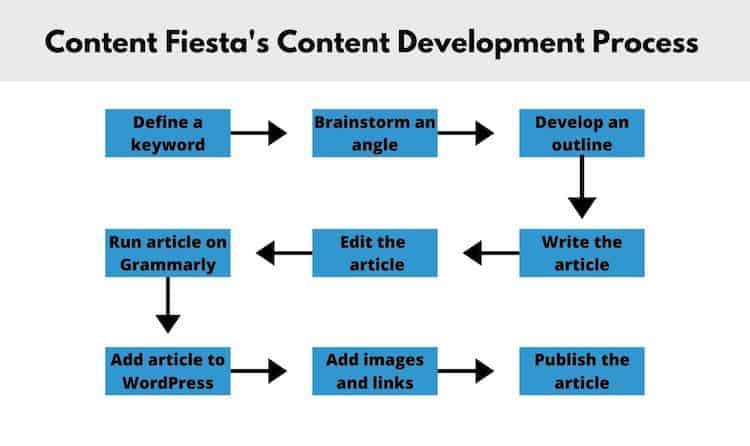
How many times have you heard praises about content marketing as a powerful marketing channel? You surely cannot count it on one hand.
There’s no denying its power to educate people and generate leads, but without an SEO strategy focused on bringing organic traffic, content marketing is just an extra element on your website, waiting to be found and used.
SEO is the best complement that content marketing has, and as such, you can’t ignore it. If you already have a content marketing strategy in place and haven’t developed an SEO plan to go along with it, you need to get started today.
Here’s how you can ensure that your content marketing strategy is SEO-oriented.
1. Analyze your current SEO performance
Start by analyzing your content marketing’s SEO performance, and to do that, you need to carry out an SEO analysis of your entire content operations.
An SEO analysis will show you how your current content performance in Google, what you are doing, and what you need to improve to boost your rankings. The analysis involves:
- Checking where you currently rank in search engines
- Checking your current crawling and indexing performance (i.e., what pages Google can crawl and index, and whether it’s ignoring key pages that you want to rank for)
- Auditing your site for technical and SEO errors
- Finding the backlinks your content has received and their authority
- Comparing how your content performs against its competitors
You can categorize each of the points mentioned above into two groups:
- On-site SEO analysis, which focuses on the way you optimize your pages to provide evidence to Google about the nature of your content.
- Off-site SEO analysis, which covers the backlinks your pages have acquired, their authority, and their nature (i.e., whether they come from natural linking, guest posts, partnerships, etc.).
To take your content marketing analysis even further, you can carry out a SWOT analysis that measures what you are doing right, what you could do to increase your rankings, and what could hinder your future results.

(Source)
2. Organize your keywords strategically
To carry out a successful SEO strategy, you need to implement keyword research—that is, the process of discovering the queries Google’s users use to search in the search engine.
You can put a keyword research process in place with the help of a keyword research tool such as WebCEO, which measures the number of monthly searches, CPC, and trends for each keyword in its database.
You can start your keyword research by adding your website to WebCEO and exporting all the keywords that your website is currently ranking for.

Then, make a list of your top competitors and export the list of keywords they rank for. With all this data, you want to:
- Create categories for your keywords by topic—e.g., all keywords about “tennis shoes” should go within one category, while the ones about “basketball shoes” go in another one.
- Create a backlog of keywords to target those that your competitors are ranking for and your website isn’t—in the future, you want to create content to target these keywords.
- Organize them by volume and CPC—you can create separate tabs for keywords with high volume and low CPC, and vice-versa.
A common mistake you want to avoid making is obsessing about volume exclusively. Intent is as important as volume because you should prioritize conversions (and growing your revenue) over driving traffic.
All keywords can be categorized in three ways:
- Commercial keywords: These keywords have a direct connection with buying—e.g., “buy tennis shoes.”
- Informational keywords: These are keywords where the user wants to find information about a topic—e.g., “what are tennis shoes.”
- Navigational keywords: These are keywords connected to specific brands, locations, and products—e.g., “nike tennis shoes.”
You can create separate tabs for each category or add a column in your keyword plan. In either case, your job is to uncover their hidden intent, which you can do by:
- Analyzing their nature: Keywords with words like “buy” or “coupon” are commercial in nature; keywords that include words like “how to” or “tutorial” are informational; keywords with specific brands, locations, or products are navigational.
- Check their CPC: Keywords with high CPC are often commercial in nature, as they convert better, while keywords with low CPC are informational or navigational.
After you have developed your keyword plan, you can start optimizing your pages according to their nature—i.e., adding commercial keywords to commercial pages, and so on.
3. Optimizing your content for SEO
After you have done your entire analysis and keyword research plan, you need to optimize your content both for SEO and quality. This last word is crucial, as marketers often end up over-optimizing their content, which alienates their readers, and this disgusts Google.
According to Google’s Webmaster Guidelines, quality content is:
- Unique, valuable, or engaging
- Made for people, not search engine’s bots
- Honest; it doesn’t deceive its readers
- Within Google’s guidelines—i.e., it doesn’t use tricks to manipulate search engine rankings
When you optimize your content for SEO, you want to make sure your content respects these guidelines. Think of your on-site optimization as the act of naturally adding keywords around your page, so Google understands what it’s about while still serving your reader.
Writing with SEO in mind is important, but only if the quality is there. If you feel that the content you produce isn’t clear, valuable, or honest, you need to rethink your content strategy altogether.
Assuming this isn’t the case, you can start carrying out your on-site optimization. Since this process is relatively simple and mechanical, you want to use a checklist that guides your marketers into optimizing the pages the right way.
At the minimum, your checklist should indicate the optimization of the following elements:
- Page Title: These are the titles that show up on the search engine result pages (SERPs). Add your keyword in your title pages.
- Density: This is the number of times a keyword shows up in your content divided by the total amount of words on the page. A good rule of thumb is showing your keyword once every 100 words; more is too much, less can be accepted, especially if you use variations of it (e.g., “buy tennis shoes,” “buy great tennis shoes”).
- Images Alt-Tags: This is a tag you use within your HTML to indicate Google the nature of your images. Add your keyword and their variations in your images’ alt-tag.
- URLs and Internal Links: Add your keywords in your URLs and internal links. If a page is already published, you can create a new page with the keyword in its URL and redirect the old “incorrect” one to the new “correct” one.
Some tools can help you with your on-site optimization, like TextOptimizer, which optimizes your content by adding or removing content from your text to improve your search engine optimization.
4. Develop a content marketing process
Content marketing is a complex process that involves several teams, stakeholders, and tasks. Your SEO optimization shouldn’t be an ad-hoc task you do every few months; it should be part of an on-going process.
The implementation of content marketing requires consistency. You want to balance your content creation and promotion with your SEO plan. For that reason, you need to have a content development process in place.
A content development process explains the steps your team takes to research ideas, prioritize, create, and promote them. It outlines the system your team uses to carry out your content marketing efforts. The one you see below represents the process I use to create content on my site; similarly, your process will show the different steps you take to do the same.

Consider developing a content calendar where you add the keywords you will target in the future with your content, who’s responsible for it, and the goals you set up. Add your keywords before the writer starts writing content; by the time they get to work on their content piece, they will have embedded your SEO in it naturally.
Your content development process will vary greatly depending on your goals, resources, and priorities. To give you an example, your process could look like this:
- Define a list of keywords to target for the next quarter.
- Assign content topics to each keyword—alternatively, ask your writers to pitch you topics for each one.
- Pick a keyword and assign it to the writer. Add a brief that explains what it should be about and the way the piece should be optimized.
- Set a deadline and ask the writer to start the article.
- Edit the content for quality and SEO—use the checklist from above.
- Publish the content and implement your marketing plan, which can include link building and outreach.
5. Leverage the power of guest posting
SEO is straightforward: to attract organic traffic from Google, you need to rank your pages. And from the hundreds of ranking factors Google uses to do so, backlinks continue to be one of the most important.
There are countless link building tactics, but one that continues to work is guest posting—the act of publishing content on third-party sites and getting links from it.
To start your guest posting, take the list of the keywords you came up with previously, and analyze each one in your SEO tool of choice.
Nico Prins explains in his thorough guide on guest posting that you can review the backlink profiles of each keyword using Ahrefs and focus on:
- The number of referring domains each page in the top result has
- The number of the referring domains that have a DR 50+ (DR is a metric Ahrefs uses to measure the authority of a domain)
According to Nico Prins, you want to pitch to sites that meet the following criteria:
- It has DR 50+
- It has 3,000+ organic visitors a month
- It has a Trust Flow over 20 (use Majestic SEO TK to measure this)
- It’s niche-relevant
Alternatively, you can use any of the following footprints to find opportunities in your niche:
- “keyword” + “become a contributor”
- “keyword” + “contribute”
- “keyword” + “guest post by”
- “keyword” + “guest post guidelines”
- “keyword” + “submission guidelines”
- “keyword” + “this guest post is from”
- “keyword” + “this guest post was written”
- “keyword” + “this is a guest article”
- “keyword” + “this is a guest post by”
- “keyword” + “write for us”
- “keyword” + inurl:guest-posts
- “keyword” + inurl:write-for-us
Add your chosen keyword where it says “keyword” (including the quotes) and make a list of all the sites you find.
Then, find the editors responsible for managing the content. You can search within each site or use LinkedIn. Before sending a pitch, find their emails with the help of a tool like Hunter.
Your pitch should be simple yet clear; send some ideas that you think their audience will like while showing respect to the editor. Here’s a framework Nico Prins recommends using:

(Source)
When you start writing your guest post, do it as if you were writing for your own site. High-domain authority sites tend to ask for high-quality content, thus to guarantee your content will be published, put quality above links.
One final tip is to use a URL shortener to track your results. With this data, you can analyze the number of visitors you drove from each site. If one site drives lots of referral visitors, you can post more than once and get not only links, but traffic.
Summary
Content marketing will continue to be one of the prime ways companies grow their online presence. When you are designing your content marketing strategy, make sure to optimize it for SEO.
- Start by analyzing your current performance.
- Create a thorough keyword research plan.
- Simultaneously, create a content development process that simplifies the entire content creation and SEO optimization tasks.
- Edit your content for SEO and quality.
- Write guest posts to attract high-quality, relevant links, and rank your pages.
Ensure your content marketing is SEO-focused. Begin by checking how your content ranks in Google.



